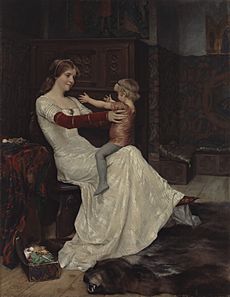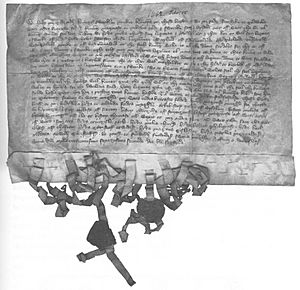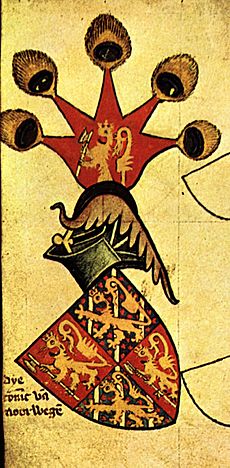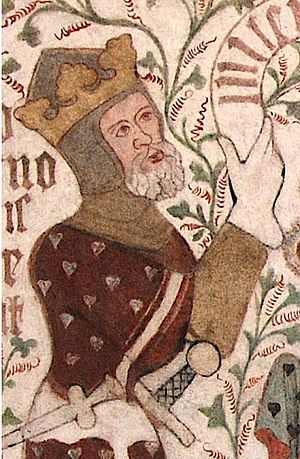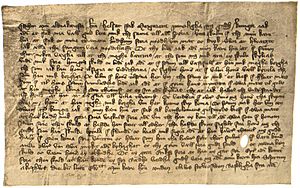Haakon VI facts for kids
Quick facts for kids Haakon VI |
|
|---|---|

The royal seal of Haakon VI
|
|
| King of Norway | |
| Reign | 15 August 1343 – 11 September 1380 |
| Predecessor | Magnus VII |
| Successor | Olaf IV |
| King of Sweden | |
| Reign | 1362–1364 |
| Predecessor | Magnus IV |
| Successor | Albert |
| Born | possibly August 1340 Likely Sweden |
| Died | September 11, 1380 (aged 40) Oslo, Norway |
| Burial | St Mary's Church, Oslo |
| Spouse | Margaret of Denmark |
| Issue | Olaf II of Denmark |
| House | House of Bjelbo |
| Father | Magnus IV of Sweden |
| Mother | Blanche of Namur |
| Religion | Roman Catholicism |
Haakon VI of Norway (Norwegian: Håkon, Swedish: Håkan; c. August 1340 – 11 September 1380) was a powerful king in the 1300s. He was King of Norway from 1343 until he died. He was also King of Sweden between 1362 and 1364. People sometimes called him Haakon Magnusson the Younger. This helped tell him apart from his great-grandfather, Haakon V of Norway.
Haakon was the younger son of Magnus Eriksson. His father was king of both Norway and Sweden. Haakon's older brother, Eric, was supposed to become King of Sweden. But Haakon was made King of Norway while his father was still alive. His father, Magnus, liked Haakon more than Eric. This led Eric to rebel and take control of Southern Sweden. Eric died in 1359. Three years later, Haakon became co-ruler of Sweden with his father.
They ruled Sweden together until 1364. Then, some Swedish noblemen, led by Bo Jonsson Grip, removed them from power. They chose Albert of Mecklenburg, Magnus's nephew, as the new king. Magnus and Haakon tried to get the Swedish throne back, but they did not succeed.
In 1363, Haakon married Margaret. She was the daughter of Valdemar IV of Denmark. This marriage was very important in the power struggles of the Nordic countries. They had one son, Olav. Haakon often had conflicts with his father-in-law, Valdemar. These fights ended only when Valdemar died in 1375. Haakon quickly made sure his son Olav was chosen as Valdemar's successor. This defeated the claims of their relatives from Mecklenburg.
When Haakon died in 1380, Olav became king. Margaret ruled as his regent. Olav died without children seven years later. Haakon's widow, Margaret, then took control over all three Scandinavian kingdoms. She became their first female ruler.
Contents
Early Life and Family
Haakon was born around August 1340, probably in Sweden. We don't know the exact date or place. His parents were Magnus Eriksson, King of Sweden and Norway, and Blanche of Namur. His older brother, Eric, was a rival king in Sweden from 1356 to 1359.
Haakon's family, the House of Bjelbo, was very important. They had ruled Sweden and Norway for a long time. Haakon was the great-grandson of Haakon V of Norway. This made him a good choice to inherit the Norwegian throne. The Norwegian nobles accepted him as their future king.
Becoming King of Norway
Haakon grew up in Norway. This was to prepare him to rule the kingdom when he was older. In the autumn of 1343, important members of the Norwegian Council of the Realm met with King Magnus. On August 15, 1343, they announced that Haakon would become King of Norway.
About a year later, people from the cities and the public met at Båhus Castle. They cheered Haakon as their king and promised to be loyal to him forever. This meeting connected Haakon to Norway's old tradition of choosing its kings. However, the Council of the Realm made sure that Haakon would only rule parts of Norway at first. They also stated that if he died without a son, the Norwegian Law of Succession would apply. This protected the idea of a king's child inheriting the throne. His older brother Eric would have been next in line, but Eric died in 1359. The decisions made in 1343 and 1344 were officially confirmed in Bergen in 1350.
Magnus gave up his Norwegian throne between August 8 and 18, 1355. Haakon then became the sole king. But his father still had some control over Norway for a few more years. Haakon's first official act as sole king was on January 22, 1358. He sent a letter approving special rights for the city of Oslo. In 1355, Norway was actually split between Haakon and Magnus. Magnus had asked for certain areas, like Hålogaland and the Norwegian islands. He also held Tønsberg and Skien. His wife, Queen Blanche, held other areas. So, Magnus's power was mainly in the southeast, near Sweden.
Becoming King of Sweden
As king, Haakon quickly got involved in his father's problems in Sweden. There was a growing conflict that turned into a war. Eric, Haakon's brother, was unhappy with his father's rule. He felt his father favored Haakon. Eric also wasn't allowed to join the Swedish Council of the Realm. Many powerful Swedish nobles supported Eric and rebelled against Magnus.
The rebellion did not last long. Magnus and Eric made peace a year later. Eric was made King of Sweden and ruled alongside his father. He also gained control over Southern Sweden. But then, Eric suddenly died of the plague in 1359.
Following the peace agreement, the Swedish nobles removed Magnus from power. They elected Haakon as King of Sweden in Uppsala on February 15, 1362. Before this, Haakon called himself "Lord of Sweden." After being elected, he changed his title to "King of Norway and Sweden."
Haakon's Marriage
In 1359, Valdemar IV of Denmark's younger daughter, Margaret, was promised to Haakon. This marriage was part of a bigger plan for an alliance between Magnus and Valdemar. Valdemar was supposed to help Magnus in the rebellion against his son Eric. He would invade Scania, a region that Sweden had controlled. In return, Valdemar would get Helsingborg Castle.
However, Eric died suddenly in June 1359. Magnus then tried to break his promise about the castle. Valdemar was a very ambitious ruler. He wanted to bring the Danish kingdom back together. So, he invaded Scania in 1360 with his army. The Danish forces quickly took over the region. They then attacked Helsingborg Castle, forcing the Swedish soldiers to give up. With the castle captured, Valdemar had almost all of Scania back. Since Magnus could not retake it by force, Scania returned to Danish rule.
More conflicts between the two kingdoms put the marriage on hold for a few years. But they finally made peace in 1363. Haakon and Margaret were married that year in the Copenhagen Cathedral. Margaret's marriage was seen as a key part of the power struggles in the Nordic region.
Rebellion in Sweden and War
In 1363, some former members of the Swedish Council of the Realm went to the court in Mecklenburg. These Swedish nobles convinced Duke Albert II of Mecklenburg to act against Magnus and Haakon in Sweden. Albert II had influence in Sweden because he married Magnus's sister, Euphemia. The nobles wanted Albert to remove Magnus and Haakon and make his son, Albert, king.
In 1364, Duke Albert got military help from powerful German nobles. He quickly invaded and conquered Sweden. He then made his son the new king. In November 1365, the younger Albert was officially recognized as Sweden's new king. He had already been crowned on February 18, 1364. Magnus found safety with his son Haakon in Norway. They immediately planned to take Sweden back.
After an invasion, a temporary peace was made. Haakon and Magnus had lost control of much of Sweden. But they still held important areas like Västergötland, Dalsland, and Värmland.
In early 1365, Haakon and Magnus gathered a large army in Västergötland. Most of the soldiers were Norwegian, but many Swedes from that area also joined. They marched towards the German-held city of Stockholm. On February 27, Haakon issued a statement against Albert of Mecklenburg. He encouraged people to rebel against the German ruler. The Norwegian army entered Uppland through Västerås. They fought the Swedish-German army in the Battle of Gataskogen. Haakon and Magnus suffered a terrible defeat. Magnus was captured and held prisoner by the Germans for six years.
Haakon's main goal now was to get Sweden back from the Germans and free his father. He still controlled West Sweden. He found support from nobles who were unhappy with the Germans. The war between Norway and Sweden continued. Haakon needed allies. He made an alliance with King Valdemar, his wife's father. This shifted Norway's focus more towards the east.
After a difficult conflict with German cities and the Hanseatic League, Haakon could focus on Sweden again. He launched a successful campaign against the Germans in Sweden. This military effort ended with the Siege of Stockholm in 1371. It looked like Haakon might finally defeat the Germans. But Albert and his German supporters held out. Haakon was forced to sign a peace treaty. The treaty was signed on August 14, 1371. Haakon had to be content with his father being released from prison. A large ransom had to be paid for Magnus. After his release, Magnus continued to rule his remaining lands in Norway and Sweden until he died in 1374.
Relations with Denmark and the Hanseatic League
In 1361, Valdemar of Denmark had invaded and taken over the Swedish region of Scania. He also captured the islands of Öland and Gotland, including the important Hanseatic town of Visby. The Hanseatic League was a powerful group of German trading cities. Their fleet attacked the Danish fleet in 1362. The Danish fleet won a major victory at the Battle of Helsingborg. The Hanseatic League was forced to agree to a humiliating peace treaty. This treaty, called the Treaty of Vordingborg, greatly reduced the League's power.
In Norway, Haakon had started to focus his foreign policy towards the east. Taking back his Swedish kingdom was his main reason for allying with Denmark. The alliance between Norway and Denmark threatened to change the balance of power in the Nordic and Baltic areas. In 1365, German protests in Bergen forced the Hanseatic trading office there to close until 1366. This hurt Norway's trade.
Valdemar could not keep the peace with the Hanseatic cities. In 1367, the League formed the Confederation of Cologne to fight Denmark and Norway. The Confederation renewed its alliance with German-held Sweden. They gathered a large fleet and attacked the Norwegian coast, raiding all the way to Agder. They also launched a successful campaign against Valdemar in Denmark. This was disastrous for Valdemar's plans to rebuild the Danish kingdom. The Confederation raided the Danish coast, invaded Danish Scania, and even captured and looted Copenhagen. This, along with rebellious nobles in Jutland, forced Valdemar to flee his kingdom in 1368.
Realizing that a long war was pointless, Valdemar appointed his advisor, Rigsdrost Henning Podebusk, to negotiate peace. The Confederation agreed to a truce. But only if Valdemar recognized their right to tax-free trade across the Baltic Sea. They also demanded renewed fishing rights in the Danish Sound. The Confederation also forced Valdemar to give them much influence over future Danish king-elections. They even got the right to veto any candidate for the throne. Finally, the Confederation took control of several towns on the coast of Scania and Helsingborg Castle for fifteen years.
On May 24, 1370, representatives from the Hanseatic cities, Denmark, and Norway signed the Treaty of Stralsund at Båhus Castle. This officially ended the war. The treaty extended the truce for another five years. Through this treaty, the Hanseatic League reached its peak power in the region. They had almost complete control over profitable trade.
This defeat was another blow to Haakon's foreign policies in the east. The power of the king weakened under the growing influence of the Hanseatic cities. Norwegian trade also suffered because of the Hanseatic monopoly. Haakon became less interested in Danish affairs after these military failures. He turned his attention back to his main goal: taking Sweden back from the Germans. He had some limited success in the following years. However, Haakon became interested in Danish affairs again when his son had a chance to become King of Denmark after Valdemar's death in 1375.
Danish Succession
On October 24, 1375, Valdemar died from illness at Gurre Castle in Zealand. The new Danish king had to be chosen by the Danish Council of the Realm. Any candidate also needed approval from the Hanseatic League. Valdemar had no clear successor. So, two candidates were put forward. Haakon and Margaret suggested their only son, Olav, as a claimant. Their brother-in-law, Henry of Mecklenburg, suggested his son Albert. Albert was their nephew.
Haakon had already lost much of his Swedish kingdom to the Germans. He was willing to go to great lengths to ensure his son became the Danish king. Haakon borrowed large amounts of money and offered it to the Hanseatic League. In return, the League agreed to stay neutral in the election. The Danish Council of the Realm also preferred an alliance with Norway. This was mainly because of anti-German feelings within the Council. They did not want another German ruler in Scandinavia.
On May 3, 1376, Olav was elected king in Slagelse, succeeding his grandfather. This election was a major victory for Haakon. It reduced German influence and greatly expanded his own power across much of Scandinavia.
Domestic Policies
In 1349, the Black Death arrived in Bergen on an English merchant ship. It had terrible effects, killing between 50% and 60% of the population. This led to a period of social and economic decline in Norway. The kingdom's financial system, which was already weak, almost collapsed. Haakon's aggressive foreign policies also put a heavy strain on the struggling economy.
In 1371, Haakon paid a large ransom of 12,000 silver marks to free his father from German prison. This amount was more than the kingdom's normal tax income before the plague. A special tax had to be put on Haakon's people to pay for the ransom.
In 1379, Haakon settled a dispute over the Earldom of Orkney. This was a Norwegian title in Scotland. On August 2, 1379, Haakon officially gave the title of Earl of Orkney to Henry Sinclair, Baron of Roslin. Sinclair was a grandson of Maol Íosa V, Earl of Strathearn. He was chosen over his cousin, Malise Sparre. In return, Sinclair promised to pay 1000 nobles by November 11 that year. He also promised to serve the Norwegian king with 100 armed men for up to three months when called upon. To ensure this, Sinclair had to leave valuable hostages when he left for his earldom. We don't know if Haakon ever called upon Sinclair's forces or if the money was fully paid. Shortly before his death in 1380, Haakon allowed the hostages to return home.
Throughout his reign, Haakon had a good relationship with the church. Also, many Swedish nobles pledged their support to Haakon and settled in Norway. This happened especially after Sweden was lost to the Germans. The reason was usually their dislike for the German ruler and his favoritism towards his own relatives. Interestingly, some German nobles from Mecklenburg also served Haakon during his reign.
Military Changes
During Haakon's time as king, the Norwegian military changed a lot. The old system of peasant conscription, called leidang, was replaced. Now, loyal Norwegian lords had direct control over the military. Haakon's predecessor had tried to create a strong civil service, including in the military. But Haakon did not continue this. Instead, he gave more power and military duties to loyal lords.
Because of this, Haakon could gather much larger armies. But it became very expensive to keep this system going. Due to the war with Sweden and Norway's aggressive policies in the east, Haakon had to borrow huge amounts of money. He relied more and more on the Norwegian nobility and rich German merchants. This large increase in foreign debt eventually shifted political power in Norway. It gradually weakened the power of the king.
Later Life and Death
Towards the end of his life, Haakon was tired from almost constant warfare. The difficult conflict with his cousin, Albert of Mecklenburg, also wore him down. Some people think this, along with his financial problems, led to his early death.
Haakon never stopped trying to get back the Swedish lands he had lost. In March 1380, he sent letters to prepare for war against the Germans in Sweden. The letters asked for the leidang fleet (a type of naval levy) to be ready to sail. It seemed the Germans had broken the peace treaty and planned to fight Haakon. However, there are no records of any wars or battles fought during this time.
Haakon died in Oslo sometime in the late summer or early autumn of 1380. He was barely forty years old. He was buried in St. Mary's Church in Oslo. His son, Olav, became the new King of Norway. Queen Margaret acted as his regent.
Family Tree
| Ingeborg of Norway | Eric, Duke of Södermanland | ||||||||||||||||||||||||||||||||||||||||||||||
| Blanche of Namur | Magnus IV of Sweden | Valdemar IV of Denmark | Euphemia of Sweden | Albert II of Mecklenburg | |||||||||||||||||||||||||||||||||||||||||||
| Eric XII of Sweden | Haakon VI of Norway | Margaret I of Denmark | Ingeborg of Demark | Henry III of Mecklenburg | Albert of Sweden | ||||||||||||||||||||||||||||||||||||||||||
| Olaf II of Denmark | Albert IV of Mecklenburg | ||||||||||||||||||||||||||||||||||||||||||||||
See also
 In Spanish: Haakon VI de Noruega para niños
In Spanish: Haakon VI de Noruega para niños


